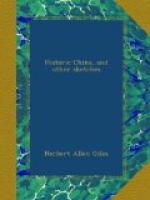“For the examination of bones the day should be clear and bright. First take clean water and wash them, and then with string tie them together in proper order so that a perfect skeleton is formed, and lay this on a mat. Then make a hole in the ground, five feet long, three feet broad, and two feet deep. Throw into this plenty of firewood and charcoal, and keep it burning till the ground is thoroughly hot. Clear out the fire and pour in two pints of good spirit and five pounds of strong vinegar. Lay the bones quickly in the steaming pit and cover well up with rushes, &c. Let them remain there for two or three hours until the ground is cold, when the coverings may be removed, the bones taken to a convenient spot, and examined under a red oil-cloth umbrella.
“If the day is dark or rainy the ‘boiling’ method must be adopted. Take a large jar and heat in it a quantity of vinegar; then having put in plenty of salt and white prunes, boil it altogether with the bones, superintending the process yourself. When it is boiling fast, take out the bones, wash them in water, and hold up to the light. The wounds will be perfectly visible, the blood having soaked into the wounded parts, marking them with red or dark blue or black.
“The above method is, however, not the only one. Take a new yellow oil-cloth umbrella from Hangchow, hold it over the bones, and every particle of wound hidden in the bones will be clearly visible. In cases where the bones are old and the wounds have been obliterated by long exposure to wind and rain or dulled by frequent boilings, it only remains to examine them in the sun under a yellow umbrella, which will show the wounds as far as possible.
“There must be no zinc boiled with
the bones or they will become
dull.
“Bones which have passed several times through the process of examination become quite white and exactly like uninjured bones; in which case, take such as should show wounds and fill them with oil. Wait till the oil is oozing out all over, then wipe it off and hold the bone up to the light; where there are wounds the oil will collect and not pass; the clear parts have not been injured.
“Another method is to rub some good ink thick and spread it on the bone. Let it dry, and then wash it off. Where there are wounds, and there only, it will sink into the bone. Or take some new cotton wool and pass it over the bone. Wherever there is a wound some will be pulled out [by the jagged parts of the bone].”
A whole chapter is devoted to counterfeit wounds, the means of distinguishing them from real wounds, and the manner in which they are produced. Section 2 of the thirteenth chapter is on a cognate subject, namely, to ascertain whether wounds were inflicted before or after death:—




